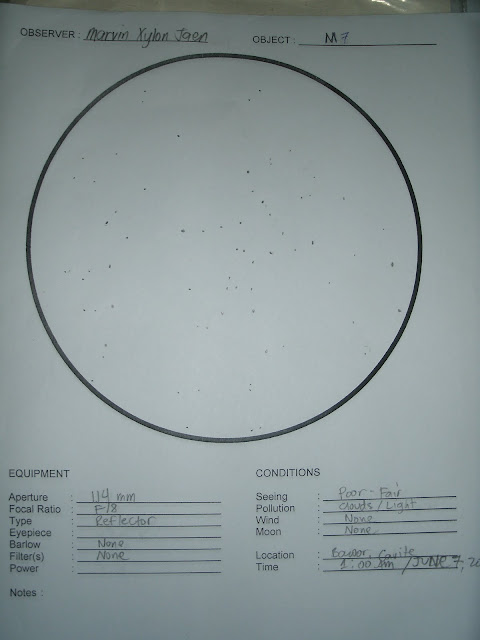The reflector is a very stable platform for planetary observation as well as deep sky hunting. The optics of the telescope performs flawlessly. The same is true with the equatorial mount, providing a stable cradle for the telescope which is very important when observing at high power.
I won the auction for this telescope with a customized dobsonian mount but being more comfortable with the equatorial mount, I made arrangements with absindex for the inclusion of an equatorial mount with additional charge of course.
Here is the package that I got :
4.5 inch - f/7.89 reflector with .965 focuser and 5x24 finderscope.
German equatorial mount with setting circles and tripod.
25 mm Huygenian eyepiece and a 12.5 mm eyepiece (to be given soon)
Custom made dobsonian mount.
Here are some photos of the reflector :
The equatorial mount is very sturdy.
The degree indicator.
The declination axis.
The right ascension axis.
Overall, a very beautiful telescope.
Performance
The Skycore M115R reflector performs well on all kinds of observation that I did.
Planetary observation is a joy in this telescope. The higher aperture allows me to use higher powers without sacrificing contrast and detail. Saturn is again a very lovely object to look at using 150x power (my highest achievable power using the 6mm eyepiece without barlow). Jupiter also shows up well at 36x power, adorned by its bright moons. Looking at Jupiter at low power is also an enchanting experience for me. Its 4 jovian moons floating around the gas giant presents an eerie scene for me. Moving up again to 150x power, Jupiter begins to show some detail like its cloud belt. However, I cannot compare the images in my telescope with other professional telescopes of 6 inch aperture and above.
During a side by side planetary test, the reflector gave brighter views of saturn and jupiter. The setup I used for the reflector was a 9 mm and 6 mm eyepiece while for the reflector, I used a diagonal and the 9 mm and 6 mm eyepiece. This may seem like a biased test since more glass (the star diagonal) is being introduced to the light path of the refractor. However, I also put into consideration that the reflector still has a secondary mirror obstructing the light path.
The reflector stood up well while the refractor started to break up the images at 150x power. It may be the seeing conditions for the night but I believe that the aperture contributes a lot to the amount of power and intricacy of detail that a telescope can handle .
Observing open star clusters is also a joy with this telescope. When I did a side by side test with the 60 mm refractor, the reflector yielded brighter images with more stars that the refractor using a 22 mm eyepiece for both telescopes and without a diagonal for the refractor.
To compare the difference between the refractor and the reflector, here are my sketches of M6 and M7 using the two different telescopes.
M6 with the reflector (June 7, 2010)
M6 with the refractor (April 8, 2010)
M7 with the reflector ( June 7, 2010)
M7 with the refractor ( April 8, 2010)
I think that these comparisons are pretty definitive by itself. A larger aperture means more light can be collected, thus we get more detail.
One problem that I have encountered with the reflector is that I cannot use my 2x barlow to get more power. Apparently, the barlow that I have is rather long and I need more inside focus for me to get a sharp image. I was adviced by guys from
cloudynights to use a short barlow lens to solve the problem.
Another problem is the finderscope of the reflector. It is an entry-level 5x24 finderscope which is not really sufficient for locating star clusters and other deep sky objects but it is adequate when locating bright stars and planets. To solve this, I "borrow" the finderscope of my refractor which is of excellent optical quality to find star clusters and just recently, globular clusters.
Apart from these problems, the telescope is a very good performer. I think I'll be enjoying the use of this telescope for the months or perhaps years to come.





